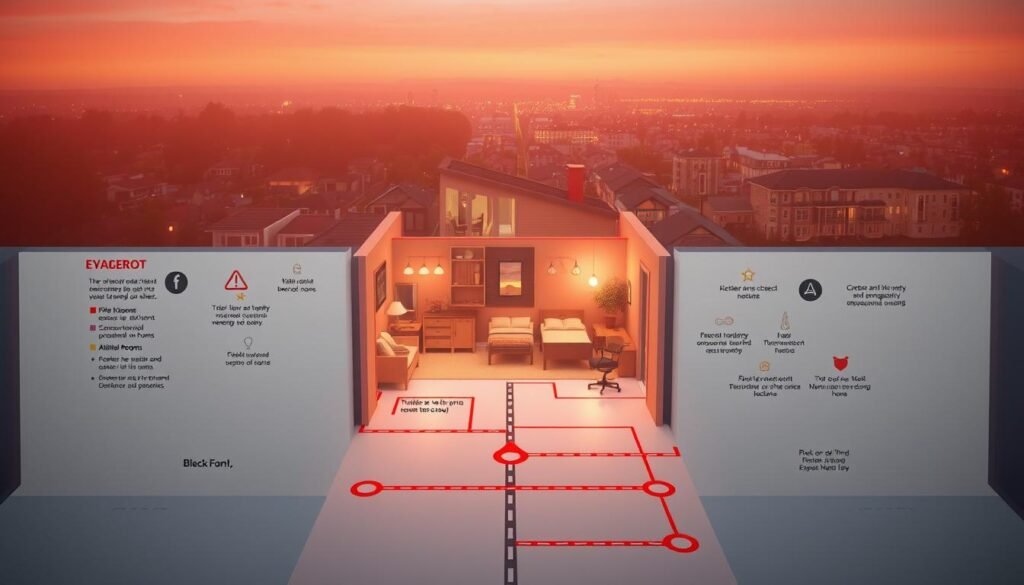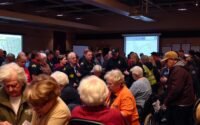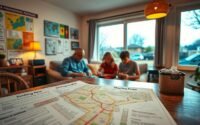Family Emergency Plan Templates: Printable & Digital
What would you do if a sudden crisis forced you to act now? That question frames this guide. You’ll learn clear steps to create and practice a family-centered plan that saves time and reduces stress when seconds matter.
Proper planning and thoughtful preparation are among the most important keys to survival. This guide draws on trusted resources like the American Red Cross and emergency manager best practices to help you document contacts, choose meeting places, and decide when to shelter or evacuate.
You’ll find practical, bite-sized actions you can use today. From contact cards to recovery checklists, the goal is simple: make preparedness part of your daily routine without feeling overwhelmed.
Key Takeaways
- Create and practice a clear plan so everyone knows what to do.
- Use trusted templates and tools to record critical information.
- Focus on quick wins first: contact cards and meeting places.
- Layer in deeper tasks like documents and recovery planning over time.
- Review and refresh your plan seasonally and after life changes.
Start Here: Why Planning Together Protects Your Family
Gather your household and map out clear steps so you act fast and confidently. Proper planning and careful consideration are your two strongest advantages. They cut confusion and speed action when every minute matters.
The Red Cross advises creating and practicing an emergency plan so each person knows roles and meeting places. An emergency manager’s framework shows that a well-thought-out plan improves response and recovery in any case.
Proper planning and consideration: your two biggest advantages
Start by aligning on a shared goal: a clear preparedness plan that makes sure everyone knows what to do, where to go, and how to communicate.
Set aside time to discuss roles, practice simple drills, and answer questions now instead of during a crisis. Use Red Cross guidance to frame your first discussion so you build on proven steps.
Bookmark this guide for ongoing updates and seasonal reminders
- Keep it family-first and scenario-light: plan for common events like fires, storms, and outages.
- Build calendar reminders to update contacts and routines each season.
- Make sure you cover different case types—at home, at work, and while traveling.
Templates for Family Emergency Plans: Printable & Digital
Use fillable worksheets and contact cards to make your family preparedness plan easy to update.
Ready-to-use guides let you capture key contact details, meeting spots, and essential documents without starting from scratch. The Red Cross offers a free family disaster plan template in English and Spanish that comes with tips to personalize the file and save a secure copy.
Create wallet-sized contact cards for each person and store the same entries on your phone. Use fillable worksheets to map escape routes, list medications, and outline school and caregiver steps.
- Keep one printed copy in a go-binder and a synced copy in a shared cloud folder.
- Include out-of-area contacts, local meeting points, and an index of important documents.
- Immigrant households can use the specialized toolkit with childcare options, legal resources, and translated versions.
| Resource | Format | Best use |
|---|---|---|
| Family disaster plan template | PDF / Fillable | Start a complete emergency plan; save a digital copy |
| Emergency contact cards | Printable / Phone | Carry wallet cards and phone contacts for redundancy |
| Fillable worksheets | Word / PDF | Record routes, school procedures, and caregiver instructions |
| Immigrant preparedness toolkit | Printable / Translated | Plan childcare, locate services, and know legal rights |
Build Your Plan in Three Practical Steps
Start by mapping the real risks that touch your daily life—home, work, school, and play. This keeps your preparedness plan practical and tied to what your household actually faces.
Discuss likely hazards where you live, learn, work, and play
Talk through the emergencies most likely in each place you spend time. List triggers that mean shelter-in-place versus evacuation so quick choices are clear.
Assign roles so every person knows what to do
Give simple responsibilities: who grabs the go-binder, who helps small children or pets, and who checks doors. Rotate duties so members can back each other up if someone is away.
Practice key parts of the plan on a regular schedule
Put short drills on the calendar. Start with table-top talks, then walk routes and move to timed evacuations when ready.
“Practice reduces stress and helps each person act with confidence when seconds count.”
- Include lifesaving actions: Drop, Cover, and Hold On; P.A.S.S. for fire extinguishers; Stop, Drop, and Roll.
- After each drill, review what worked and update the plan make notes to improve the next run.
| Step | Focus | Quick win |
|---|---|---|
| 1 | Risk talk | List local hazards |
| 2 | Roles | Assign one task per person |
| 3 | Practice | Schedule short drills |
Plan for Common Emergencies in Your Area
Start by identifying the real threats near your home so your plan targets what matters most.
Use local hazard maps and alerts to list the top emergencies in your area. Focus on fires, floods, severe weather, and any region-specific events like tornadoes or hurricanes.
Home fires, floods, severe weather, and region-specific hazards
Map two exits per room and pick an outside meeting point just beyond your front yard. Practice staying low under smoke and moving quickly to that spot.
For floods, identify routes to higher ground and note alternatives if roads or bridges close. For severe weather, mark a safe interior room or a community shelter and pack essential supplies.
Shelter-in-place versus evacuation: how to decide in real time
Use a simple rule: if the threat is outside—shelter inside; if it is inside—evacuate. Know the difference between a watch and a warning: a watch means stay alert; a warning means act now.
“Decide ahead where you’ll meet: one spot just outside the house and one outside the neighborhood.”
- Keep local shelter locations, evacuation routes, and transit options in your emergency plan.
- Record contacts and key information so decisions are quick in any case.
If You’re Separated: Communication, Reunion, and Emergency Contacts
If people in your home get separated, a few set rules will speed communication and safe reunions.
Choose two meet-up places: one just outside your home and one outside the neighborhood. Practice routes to each from school, work, and common community spots so movement is automatic under pressure.
Pick an out-of-area contact as your central relay. Long-distance texts often go through when local lines fail. Teach everyone to text that person first and use group messages to update multiple people at once.
- Carry written emergency contact cards with names, numbers, medical notes, and access needs, and save the same contact information on cell phones under ICE labels.
- Add caregiver contacts and school procedures for kids; list mobility aids, meds, and backup power needs for older adults and people with disabilities.
- Make a clear check-in routine for members who live away—students, military, or travelers—so reunions are timely and safe.
“Turn on alerts in the Red Cross Emergency app and practice sending a check-in text and sharing live location.”
Evacuation Maps, Shelter Spaces, and Special Considerations at Home
Begin with a simple drawing of your home that shows two ways out of every room. Use graph paper and sketch each level. Mark the fastest route to your outside meeting place and a second route in case the primary one is blocked.

Draw exit routes and pick two meeting places
Identify one near-home meeting place and one outside the neighborhood. Write both on the first page of your disaster plan so members can recall them under stress. Repeat the map exercise for multi-level homes.
Set up a safe interior room
Choose a windowless interior room on the lowest level as your shelter-in-place space. Stock it with water, snacks, lights, and calm activities that help children stay settled.
If the area faces a respiratory hazard, turn off HVAC and seal gaps with tape and plastic until authorities say it is safe.
Plan for children, older adults, people with disabilities, and pets
- List mobility aids, spare eyeglasses, chargers, and care items in your plan.
- Practice P.A.S.S. with a fire extinguisher and review Stop, Drop, and Roll and Drop, Cover, and Hold On for quakes.
- Pack lightweight emergency kits for each person and a pet kit with carrier and supplies; note pet-friendly hotels along evacuation routes.
- Rotate roles during drills and make backups so one absent person won’t block a critical task.
“A clear map and a practiced meeting plan cut confusion when every second matters.”
| Task | Quick action | Who is responsible |
|---|---|---|
| Home map | Sketch two exits per room | Lead adult + one child helper |
| Meeting places | Choose near-home and out-of-area spots | All members confirm |
| Shelter room | Stock water, lights, snacks | Primary caregiver |
| Special needs | List aids, meds, chargers | Assigned support member |
Essential Lists, Kits, and Important Documents
A compact kit and organized documents make the hardest hours after a disaster far easier to manage.
What to include in your emergency kit
- Water (one gallon per person per day) and three days of shelf-stable food.
- First-aid supplies, flashlights or headlamps, batteries, power banks, and a battery/crank radio.
- Daily medications, backup eyeglasses, infant or pet supplies, and small comfort items to reduce stress.
- Store one kit at home in an easy-to-grab spot, smaller kits in cars, and a workplace pouch so you always have basics nearby.
Keep original documents in a waterproof pouch and keep secure copies elsewhere. FEMA recommends IDs, Social Security cards, birth and marriage certificates, insurance policies, bank and credit info, medical records, and prescription lists.
Keep encrypted digital copies in cloud storage and a password-protected USB. Add recent photos of people and pets so ID and reunification are faster.
Carry a compact plan package
- Place a printed plan template, current contact sheet, and a USB with scanned records in a go-binder so you can grab everything at once.
- Schedule quarterly checks to refresh water, rotate food, and update document copies as needed.
Community resources and multilingual support
Link to local services and trusted legal contacts, and keep a multilingual toolkit if language access may be needed. Immigrant households can store abridged rights information in their wallet and a full toolkit at home.
“A short list and a secure copy of key documents are one of the best parts of a solid disaster preparedness plan.”
Use this grab-and-go checklist to finish your kit and document copies: grab-and-go checklist.
Conclusion
Bring everything together with a few steady steps that keep your plan active and trusted.
You now have the pieces to build a simple preparedness plan that works at home and on the go. Reconfirm meeting places, verify emergency contacts saved in cell phones, and update contact information as life changes.
Keep a visible go-binder and a synced backup of important documents. Practice small drills each month so responses become natural. Use Red Cross guides and an emergency binder checklist to refine your family disaster plan.
Make sure your plan stays current: set calendar reminders, rotate supplies, and revisit roles after major changes. Proper planning and careful consideration reduce panic and help everyone act with confidence when it matters most.
FAQ
How do I start a preparedness plan with my household?
Begin by gathering everyone to talk about likely emergencies where you live, work, learn, and play. List contacts, medical needs, and meeting spots. Assign simple roles and create a short, written plan you can update each season.
What information should be on emergency contact cards and phone lists?
Include full names, phone numbers (mobile and landline), email addresses, an out-of-area contact, home address, and any critical medical details like allergies or medications. Add school and caregiver contacts and note preferred meeting places.
Where should I store important documents and digital backups?
Keep paper copies in a waterproof, fire-resistant box or a portable folder. Scan documents and save encrypted copies in cloud services like Google Drive or OneDrive and on a USB you store securely. Share access instructions with a trusted family member.
How often should I review and practice the plan with my children?
Review contacts and roles every three months and run short drills every six months. Practice key parts—exit routes, meeting spots, and shelter-in-place procedures—so children and caregivers know what to do under stress.
How do I decide whether to shelter-in-place or evacuate?
Check official guidance from local emergency management and the Red Cross. Shelter-in-place if hazards are outside (chemical plume, severe winter storm). Evacuate when officials order it or if your home is unsafe from fire, flood, or structural damage.
What should go in a basic home emergency kit?
Pack water (one gallon per person per day for 3 days), nonperishable food, a first-aid kit, flashlights, extra batteries, a manual can opener, copies of IDs and documents, cash, sanitation items, and any prescription meds for at least 3–7 days.
How can I include older adults, people with disabilities, or pets in the plan?
List medical equipment, mobility needs, medication schedules, and caregiving contacts. Identify accessible evacuation routes and pet-friendly shelters. Prepare an extra bag with supplies specific to each person or pet.
What should I do if a family member is away at college, in the military, or traveling?
Create an out-of-area contact for the whole family and share a simplified reunion plan. Make sure the person away has digital access to key contacts, a local meet-up location, and instructions for notifying family if they can’t reach you directly.
Are there bilingual or multilingual resources for immigrant families?
Yes. Look for toolkits and templates in English and Spanish from the American Red Cross, FEMA, and local emergency management. Community centers and libraries often provide translated materials and help filling out plans.
How can I make my evacuation map and meeting places clear and easy to use?
Draw simple exit routes from each room and mark two meeting spots: one close by and one out-of-neighborhood. Post the map near exits and keep a copy in your emergency kit and on each caregiver’s phone for quick reference.
What digital tools and apps help with alerts and communication?
Install apps like the FEMA app, American Red Cross Alerts, and local emergency management apps. Enable wireless emergency alerts on cell phones and create a shared contact group so you can text or call multiple family members quickly.
How should I store and share the plan so everyone can access it during a disaster?
Keep a printed copy in a central place like the kitchen, store a portable folder in your emergency kit, and save an encrypted digital copy in the cloud. Share a short checklist via text or email to caregivers and trusted contacts.
Can schools and caregivers follow the same worksheet templates I use at home?
Yes. Use fillable plan worksheets tailored for home, school, and caregivers so everyone has consistent contact info, medical details, and meeting instructions. Provide copies to schools, daycare providers, and babysitters.
How do I protect documents and identity information during and after a disaster?
Use waterproof, fire-resistant storage for originals. Scan and encrypt digital copies, enable two-factor authentication on accounts, and consider identity-theft protection services. Report lost or stolen documents to local authorities promptly.
What community resources should I include in my preparedness plan?
Add local emergency management contacts, nearby evacuation shelters, the nearest hospital and fire station numbers, utility company outage lines, and community centers that host disaster response. Keep multilingual resource links if needed.


